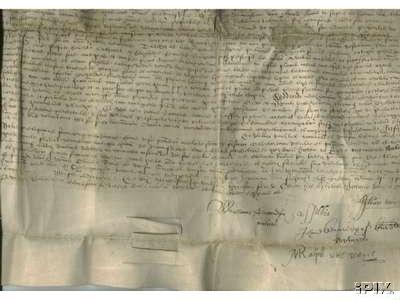|
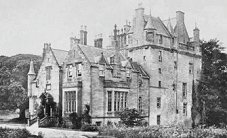 Cassillis
House (photo contributed by Davie Law) stands by the Doon about three miles from Maybole. It is not known when it
was built, but Grose, the antiquarian, conjectures it to have been erected about
the time of Queen Mary, although it was probably earlier. The house was
considerably modernised in 1830, but the old tower still forms the main body of
the building while the Dule Tree (seen to the left in the engraving) waves its
branches, and the Doon sweeps past its walls as of yore. The
history of Cassillis is uneventful, and it would probably never have been heard
of half a mile from the parish in which it stands had it not been for a romantic
story which has carried its fame far and wide. Here is the story: Cassillis
House (photo contributed by Davie Law) stands by the Doon about three miles from Maybole. It is not known when it
was built, but Grose, the antiquarian, conjectures it to have been erected about
the time of Queen Mary, although it was probably earlier. The house was
considerably modernised in 1830, but the old tower still forms the main body of
the building while the Dule Tree (seen to the left in the engraving) waves its
branches, and the Doon sweeps past its walls as of yore. The
history of Cassillis is uneventful, and it would probably never have been heard
of half a mile from the parish in which it stands had it not been for a romantic
story which has carried its fame far and wide. Here is the story:
|
The
gypsies cam' to oor gude lord's yett,
And O, but they sang sweetly;
They sang sae sweet and sae very complete,
That doon cam' oor fair ladye.
As
sune as they saw her weel-faured face
They coist the glamour ower her.
"O
conie wi' me," says Johnnie Fan,
"O, come wi' me, my deane,
For I vow aud I swear by the hilt o' my sword,
That your lord shall nae mair come near ye."
And
when oor Lord cam' hame at e'en,
And speered for his fair ladye,
The tane she cried, and the ither replied,
"She 's awa' wi' the gypsy laddie."
"Gae
saddle to me the black, black steed,
Gae saddle and mak' him ready.
Before that 1 either eat or sleep,
I 'll gae seek my fair ladye."
And
we were fifteen wed-made men,
Although we werna bonny,
And we were a' put doon but ane,
For a fair young, wanton ladye.
|
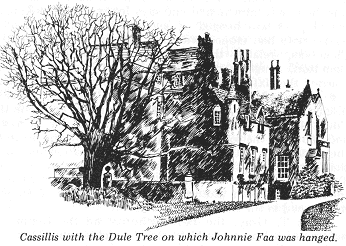 |
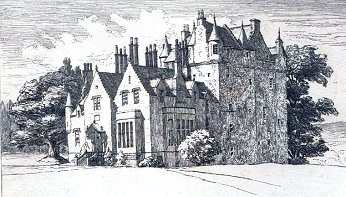 |
 Such
is the story; and if any one asks for proof of the truth of it, all we can say
is that the ballad is our authority. And ballads, although not exactly
historical, are generally founded on fact; and while granting that we cannot
point to any particular date, or any particular person, we hold that an event
once happened in connection with Cassillis, such as the old ballad describes. Such
is the story; and if any one asks for proof of the truth of it, all we can say
is that the ballad is our authority. And ballads, although not exactly
historical, are generally founded on fact; and while granting that we cannot
point to any particular date, or any particular person, we hold that an event
once happened in connection with Cassillis, such as the old ballad describes.
Besides
the Dule Tree and the "Gypsie's Steps," there is little of interest to
be seen about Cassillis now; but twenty years ago,
 the visitor to the old place
was shewn the tearful portrait of the run-away lady herself, arid a piece of
tapestry wrought by her, depicting the elopement, both of which have now
disappeared; while a trap door used to be uplifted revealing the old dungeon of Cassillis, whence "cart-loads of human bones were once removed, telling, it
was to be feared, of deeds and times long gone by, when the devoted guest or the
refractory vassal went so frequently amissing, having met a fate which some
might suspect, but none durst inquire into." The reader who can receive
this as historical need not scruple to receive Johnnie Fan's story too.
From Places of Interest
About Maybole by Rev. R L Lawson . the visitor to the old place
was shewn the tearful portrait of the run-away lady herself, arid a piece of
tapestry wrought by her, depicting the elopement, both of which have now
disappeared; while a trap door used to be uplifted revealing the old dungeon of Cassillis, whence "cart-loads of human bones were once removed, telling, it
was to be feared, of deeds and times long gone by, when the devoted guest or the
refractory vassal went so frequently amissing, having met a fate which some
might suspect, but none durst inquire into." The reader who can receive
this as historical need not scruple to receive Johnnie Fan's story too.
From Places of Interest
About Maybole by Rev. R L Lawson .
See another
story about Cassillis House and Johnny Faa by D.C. Cuthbertson from his book
Carrick Days.
|
|
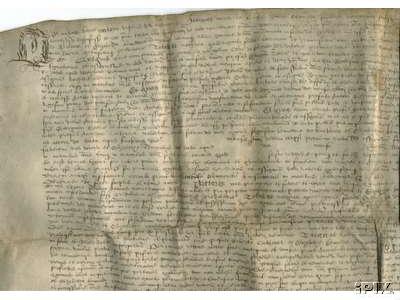
|
This is an original land deed dated 31 Oct 1632 for the
post-marital transfer of Cassillis House Castle, situated in Maybole in
the heart of Burnís country - home of the Kennedy Clan.
Hand written in
Latin on animal skin the document is a charter of resignation and novodamus by John Kennedy, earl of Cassillis, in favour of Robert Cathcart,
second Son of James Cathcart of Balneill and Elizabeth Kennedy, Wife of
Robert, in conjunct ferffment, and to their heirs in tail of the 40s. land
of Drumuskane, in Kirkoswald parish. It is dated 31 Oct. 1632.
The lands
are described as formerly pertaining to George Corrie of Kelwood, who
disponed them to Gilbert Kennedy of Dinevin, formerly of Monontcheoun, and
others in April and May 1615. Gilbert disponed them to James Cathcart of
Balneill, and they subsequently formed part of a marriage contract between
James Cathcart and Robert his Son on the one part and George Kennedy of
Knockdaw and Elizabeth Kennedy his daughter, now Wife of Robert. The Earl
confirms this as feudal superior of the lands. A transcript of the
pertinent points is provided with this document as is a letter of
authenticity.
The document is in near mint condition and comes folded in
the required style of the time. It really is a truly rare and historic
document and an important part of the Kennedy Clanís history. Also
included are several Scottish letters relating to poor laws etc. as a
piece of general Scottish history and the Handbook of Conveyancing
Practice in Scotland by John H. Sinclair, second edition. This modern day
law book details the ancient laws of land ownership and transfer. |









